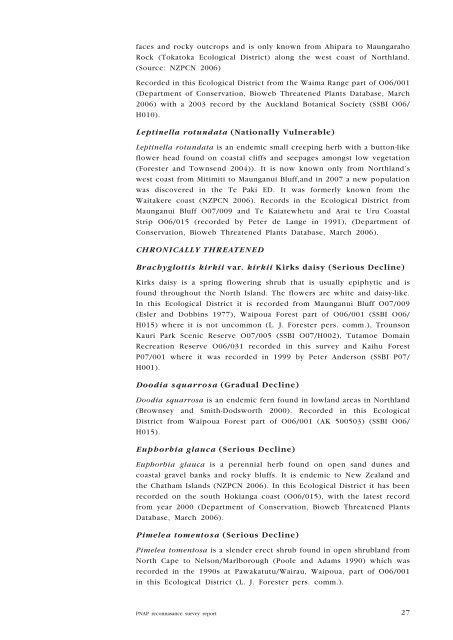Natural areas of Tutamoe Ecological District (3. Ecological character)
Natural areas of Tutamoe Ecological District (3. Ecological character)
Natural areas of Tutamoe Ecological District (3. Ecological character)
You also want an ePaper? Increase the reach of your titles
YUMPU automatically turns print PDFs into web optimized ePapers that Google loves.
faces and rocky outcrops and is only known from Ahipara to Maungaraho<br />
Rock (Tokatoka <strong>Ecological</strong> <strong>District</strong>) along the west coast <strong>of</strong> Northland.<br />
(Source: NZPCN 2006)<br />
Recorded in this <strong>Ecological</strong> <strong>District</strong> from the Waima Range part <strong>of</strong> O06/001<br />
(Department <strong>of</strong> Conservation, Bioweb Threatened Plants Database, March<br />
2006) with a 2003 record by the Auckland Botanical Society (SSBI O06/<br />
H010).<br />
leptinella rotundata (Nationally Vulnerable)<br />
Leptinella rotundata is an endemic small creeping herb with a button-like<br />
flower head found on coastal cliffs and seepages amongst low vegetation<br />
(Forester and Townsend 2004)). It is now known only from Northland’s<br />
west coast from Mitimiti to Maunganui Bluff,and in 2007 a new population<br />
was discovered in the Te Paki ED. It was formerly known from the<br />
Waitakere coast (NZPCN 2006). Records in the <strong>Ecological</strong> <strong>District</strong> from<br />
Maunganui Bluff O07/009 and Te Kaiatewhetu and Arai te Uru Coastal<br />
Strip O06/015 (recorded by Peter de Lange in 1991), (Department <strong>of</strong><br />
Conservation, Bioweb Threatened Plants Database, March 2006).<br />
chrOnIcAlly threAtened<br />
Brachyglottis kirkii var. kirkii Kirks daisy (Serious Decline)<br />
Kirks daisy is a spring flowering shrub that is usually epiphytic and is<br />
found throughout the North Island. The flowers are white and daisy-like.<br />
In this <strong>Ecological</strong> <strong>District</strong> it is recorded from Maunganui Bluff O07/009<br />
(Esler and Dobbins 1977), Waipoua Forest part <strong>of</strong> O06/001 (SSBI O06/<br />
H015) where it is not uncommon (L. J. Forester pers. comm.), Trounson<br />
Kauri Park Scenic Reserve O07/005 (SSBI O07/H002), <strong>Tutamoe</strong> Domain<br />
Recreation Reserve O06/031 recorded in this survey and Kaihu Forest<br />
P07/001 where it was recorded in 1999 by Peter Anderson (SSBI P07/<br />
H001).<br />
doodia squarrosa (Gradual Decline)<br />
Doodia squarrosa is an endemic fern found in lowland <strong>areas</strong> in Northland<br />
(Brownsey and Smith-Dodsworth 2000). Recorded in this <strong>Ecological</strong><br />
<strong>District</strong> from Waipoua Forest part <strong>of</strong> O06/001 (AK 500503) (SSBI O06/<br />
H015).<br />
euphorbia glauca (Serious Decline)<br />
Euphorbia glauca is a perennial herb found on open sand dunes and<br />
coastal gravel banks and rocky bluffs. It is endemic to New Zealand and<br />
the Chatham Islands (NZPCN 2006). In this <strong>Ecological</strong> <strong>District</strong> it has been<br />
recorded on the south Hokianga coast (O06/015), with the latest record<br />
from year 2000 (Department <strong>of</strong> Conservation, Bioweb Threatened Plants<br />
Database, March 2006).<br />
Pimelea tomentosa (Serious Decline)<br />
Pimelea tomentosa is a slender erect shrub found in open shrubland from<br />
North Cape to Nelson/Marlborough (Poole and Adams 1990) which was<br />
recorded in the 1990s at Pawakatutu/Wairau, Waipoua, part <strong>of</strong> O06/001<br />
in this <strong>Ecological</strong> <strong>District</strong> (L. J. Forester pers. comm.).<br />
PNAP reconnasance survey report<br />
27

















